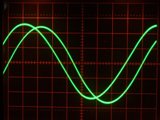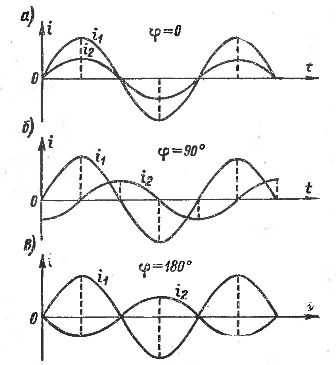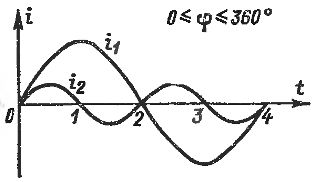Phase shift for alternating currents
 Alternating currents the same frequency they can differ from each other not only in amplitude, but also in phase, that is, they can be phase-shifted.
Alternating currents the same frequency they can differ from each other not only in amplitude, but also in phase, that is, they can be phase-shifted.
If two alternating currents simultaneously reach peak values and simultaneously pass through zero values, then these currents are in phase. In this case, the phase shift between the currents is zero (Fig. 1, a).
However, there are cases when the values of the amplitude (and the zero) of these currents do not coincide with each other in time, that is, there is one or another phase shift that is not equal to zero. In fig. 1b shows currents that are phase shifted by a quarter of the period (T / 4).
The phase shift is usually denoted by the Greek letter φ and is often expressed in degrees, assuming that the entire period is 360°, just as one complete revolution corresponds to 360°. Thus, the phase shift by a quarter of the period is denoted by φ = 90 °, and when the phases are shifted by half the period, they write φ = 180e.

Rice. 1. Different phase shifts between two alternating currents
The relationship between the period of the alternating current T and the angle 360 ° can be established from the experiment in which an alternating sinusoidal EMF is obtained with uniform rotation of the coil (or coil) in a uniform magnetic field. In this case, for one turn of the coil, i.e. during its rotation through an angle of 360 °, the EMF makes one complete sinusoidal oscillation. Thus, in fact, the period T corresponds to an angle of 360 °.
The same follows from the mathematical expression for alternating current, that is, from its equation. If alternating current started its change from the zero phase when t = 0, ωt = 0 and sin ωt = 0, after one period it will turn out

At this point the phase angle is 2π radians or 360 ° and therefore sin ωt = sin 2π = sin 360 ° = 0. When the angle changes from 0 to 2π radians or 360 °, the sine makes a complete cycle of its changes. Accordingly, the alternating current makes one complete oscillation.
It must be remembered that only currents of the same frequency can have a well-defined phase shift. At different frequencies of the currents, the phase shift between them is not constant, but changes all the time. For example, for currents i1 and i2 shown in Fig. 2 and with frequencies that differ from each other by a factor of two, the phase shift at the time instants depicted by points 0, 1, 2, 3, 4 is 0, respectively; 90; 180; 270; 360 °, i.e. during one period of current i1, the value of φ varies from 0 to 360 °.
Rice. 2. Variable phase shift between currents of different frequencies
Everything said about the phase shift between currents also applies to voltages and electromotive forces. Below we will consider cases where there will be a phase shift between voltage and current.

